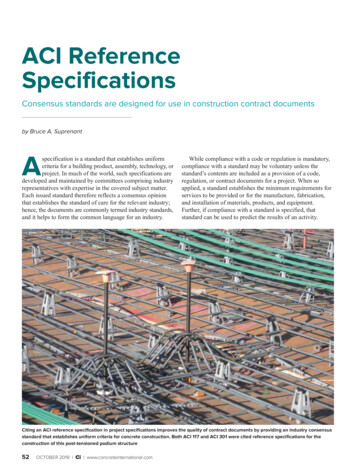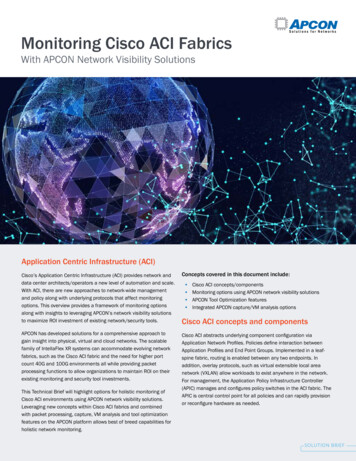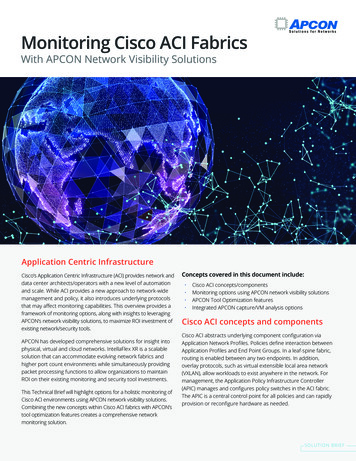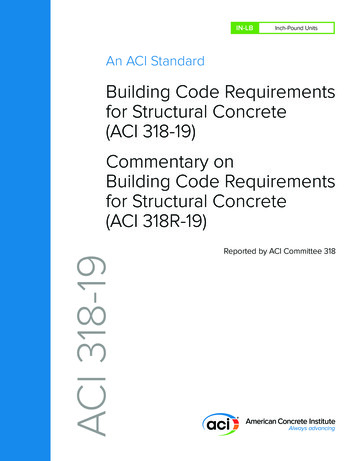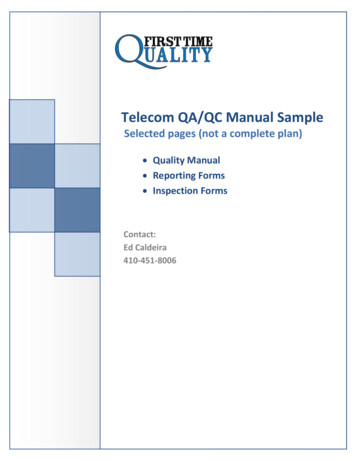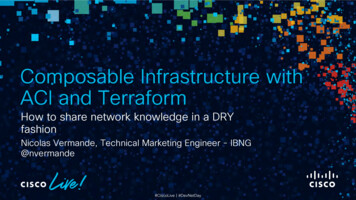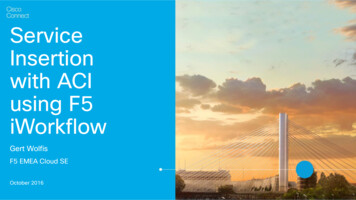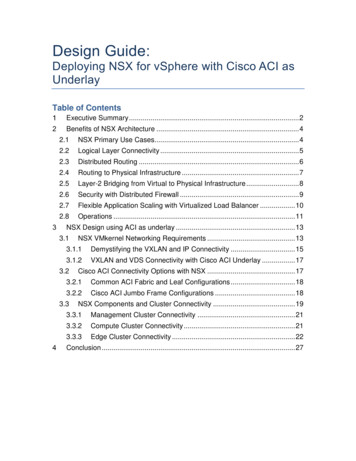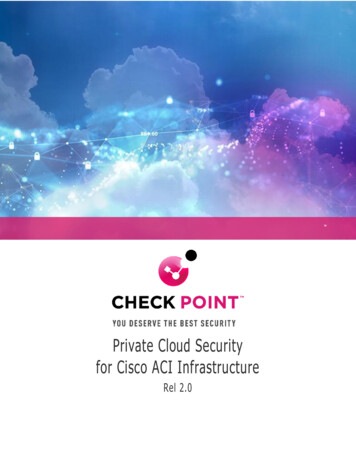
Transcription
PRIVATE CLOUD SECURITY FORCISCO ACI INFRASTRUCTUREPrivate Cloud Securityfor Cisco ACI InfrastructureRel 2.01
PRIVATE CLOUD SECURITY FORCISCO ACI INFRASTRUCTURETABLE OF CONTENTSIntroduction.3Cisco ACI Overview .4Terminology and Definitions .4Deployment Modes .6Cisco ACI environment . 10Check Point Integration with Cisco ACI . 19Check Point and Cisco ACI Integration Benefits . 23Single and Multi-Pod Overview . 26Integrating Check Point Firewalls to the ACI Infrastructure . 28Single Pod Security Design . 32Single Pod overview . 32Check Point Security Appliances for Single Pod . 34VSX Cluster Design for Single Pod Security Deployment . 34Traffic Flows in the Single Pod Architecture . 35Check Point Maestro for Single Pod . 40Check Point Maestro with VSX/VSLS for Single Pod . 41Security Appliances Fleet with Symmetric PBR Load Balancing design . 42Multi-Pod Security Design . 43Multi-Pod Security Design with dedicated Bridge Domains . 46Maestro design with Active/Standby MHOs per pod . 48VSX/VSLS design with the cluster per pod . 49Maestro plus VSLS Cluster design with MHO Cluster . 49Multi-Pod Security Architecture with stretched Bridge Domains . 50Multi-Site Security Design . 64Summary. 662
PRIVATE CLOUD SECURITY FORCISCO ACI INFRASTRUCTUREIntroductionAs companies are embarking on their application and data modernization programs and considering cloud andinfrastructure requirements, they will most likely opt for a hybrid cloud strategy, with application and data workloadsspread across both public and private clouds.In hybrid deployments, hyper-scalers combine the cloud benefits of innovation, speed, consumption, and scale of thepublic cloud with the benefits of private clouds, such as regulatory compliance, performance, data gravity, andrecouping existing investments. Furthermore, hybrid deployments provide the same level of operation andmanagement in both public and private cloud environments, e.g., unified management, flexibility, agility.Cisco Application Centric Infrastructure (ACI) is a mature SDN (Software Defined Network) technology that offersenterprises of all sizes "cloud-like" performance, availability, resilience, monitoring, and automation. Enterprises thatwant to build their own on-premise private clouds will find Cisco ACI provides most if not all the features they needto do so. The cloud-like features of Cisco ACI enable customers to leverage a fundamentally more secure approachto data and network security by moving to a security model independent of routing and network topology.Check Point CloudGuard for Cisco ACI delivers industry-leading security management and enforcement tailored toprotecting customer information assets. Security service insertion in modern, application-centric private and hybridcloud networks is sophisticated, yet simple, way to design, deploy, scale and operate in a complex environment.3
PRIVATE CLOUD SECURITY FORCISCO ACI INFRASTRUCTURECisco ACI OverviewCisco ACI provides an open security policy framework that expresses policies using the languageof applications rather than networks. So, instead of using classical networking constructs likeVLANs, IPs, and MAC addresses, policies are defined in a language that is natural for applicationowners. The security policy and segmentation are decoupled from the underlying topology of thenetwork through a group-policy approach.Terminology and DefinitionsApplication Centric Infrastructure - ACIA software-defined data center solution that applies an application-centric policy model to enablerapid application deployment. ACI data center infrastructure should be deployed in a spine-leaftopology and run on Cisco Nexus 9000 series switches.Cisco APICCisco APIC is the main architectural component of Cisco ACI. It automates and manages the CiscoACI fabric, enforces policies, and monitors health. Cisco APIC establishes, stores, and enforcesCisco ACI application policies based on the application's network requirements. Cisco APIC alsoprovides policy authority and resolution mechanisms.It is important to distinguish between two views when looking at Cisco ACI and Check PointSecurity Gateways integration: Logical and Infrastructure. Infrastructure - relates to all thephysical components: switches, routers, etc. Logical is used to set up communication betweenworkloads within the switch fabric.ACI Policy ModelACI policy models provide a convenientmeans of specifying applicationrequirements, which APIC thentranslatesintoanetworkinfrastructure. A number ofconstructs are included in thisobject-oriented model, includingtenants, contexts, bridge domains,endpoint groups, and servicegraphs.Figure 1: Cisco ACI Policy Model1, Source: Cisco Systems4
PRIVATE CLOUD SECURITY FORCISCO ACI INFRASTRUCTUREPolicy models are based on promise theory, allowing declarative, scalable control of intelligentobjects. Promise theory relies on the underlying objects handling configuration state changesinitiated by the control system. This reduces the complexity of the controller and allows for greaterscalability.Figure 2: Spine and Leaf Topology1SpineSpines are special switches that form the backbone of ACI networks. All leaf switches must beconnected to spines, and spines handle leaf-to-leaf communication. Spine switches typicallycontain a large number of high bandwidth (40 /100 GbE) aggregation ports. The ACI fabric relieson these ports for bandwidth throughput.LeafsACI's spine-leaf topology uses leaf switches to connect all endpoint devices, such as servers,routers or firewalls, to the ACI fabric. Leaf switches can be defined based on the roles attachedto endpoints by enabling all of them to connect at the same layer: 1Computing Leaf Switches - Used to connect to computer systems.Service Leaf Switches - Used to connect to Layer 4-7 service devices, such as applicationload balancers and firewalls.IP Storage Leaf Switches - Used to connect to IP storage systems.Border Leaf Switches - Used for external connectivity. External routers are supportedfor routing and policy enforcement for traffic between internal and external endpoints.Source: Cisco Data Center Spine-and-Leaf Architecture: Design overview White perc11-737022.html5
PRIVATE CLOUD SECURITY FORCISCO ACI INFRASTRUCTURE Transit Leaf Switches - Used to connect to the spines on other data centers. It existsonly in stretched fabric topologies.Management Leaf Switches - Used to connect to the OOB Network for the Operationsand Management Services for the infrastructure.Figure 3: Logical mapping of components to the infrastructure in the Switch Fabric.Deployment ModesIn traditional data centers design, Cisco Systems typically used to refer to three tiers: core,aggregation, and access, while modern and advanced data centers design is typically based on atwo-tier spine-leaf architecture. The new approach offers a more optimized design toaccommodate east-to-west traffic flows, which are predominant in the new application based onthe following design patterns.Single PodAPIC pods are sets of interconnected leaf and spine switches (ACI Fabrics) that are under thecontrol of an APIC cluster.Figure 4: Single Pod Architecture6
PRIVATE CLOUD SECURITY FORCISCO ACI INFRASTRUCTUREMulti-PodThe Multi-pod2 is an architectural design that has multiple ACI fabrics under the control of singlemanagement or administration.InterPod Network (IPN)The pods within the topology are all connected via IP-routed Inter-Pod Network3, a transport typeconnection that enables IP Routing and Multicast in order to allow interconnection between pods,and connectivity within pods to the IPN occurs on spine nodes. IPN is not managed by APIC andneeds to be configured independently.Figure 5: Multi-Pod & InterPod Network Architecture2Source: Cisco ACI Multi-Pod White Paper - : Cisco ACI Multi-Pod White Paper, Inter-Pod Connectivity Deployment Considerations - odConnectivityDeploymentConsiderations7
PRIVATE CLOUD SECURITY FORCISCO ACI INFRASTRUCTUREMulti-SiteThe Multi-site4 architecture is the interconnection of APIC cluster domains with their associatedpods. Multi-Site designs may also be called Multi-Fabric designs since they interconnect separateavailability zones (ACI fabrics), deployed either as single pods or multiple pods (Multi-Pod design).InterSite Network (ISN)All communications between endpoints (EPG's) can be accomplished using site-to-site VPNs(Virtual Extensible Local Area Network) over a generic IP network that connects different siteswith the InterSite Network5. Using VXLAN encapsulation for the InterSite IP network greatlysimplifies the setup of the configuration. Other than routing capabilities and increased maximumtransmission unit (MTU) size (given the overhead created by the VXLAN encapsulation), this IPnetwork does not have any other specific functional requirements.Figure 6: Multi-Site and Inter-Site Network ArchitectureIn a Multi-Site topology, each fabric could be considered a separate availability zone. Theseavailability zones are managed cohesively by the Multi-Site Orchestrator. The nature of the4Source: Cisco ACI Multi-Site White Paper - : Cisco ACI Multi-Site White Paper, Intersite Network (ISN) deployment considerations - iteNetworkISNdeploymentconsiderations8
PRIVATE CLOUD SECURITY FORCISCO ACI INFRASTRUCTUREarchitecture ensures that whatever happens to one site (availability zone) in terms of networklevel failures and configuration mistakes will not impact other site(s) or availability zones. Thisguarantees business continuance at the highest level.There is a misconception that Multi-Site somehow supersedes Multi-Pod or that the Multi-Podarchitecture is no longer relevant. In reality, they are two separate technologies applicable todifferent use cases.Furthermore, there is no valid reason for Multi-Pod and Multi-Site topologies not to work together.For example, there could be multiple data centers deployed all over the world, but each can haveits own ACI Multi-Pod fabric and tied together through the Multi-Site Orchestrator. These twoarchitectures are built to work harmoniously, so you are no longer faced with an either/or decisionand will ultimately have a high degree of deployment flexibility.Figure 7: Multi-Pod and Multi-site architecture9
PRIVATE CLOUD SECURITY FORCISCO ACI INFRASTRUCTURECisco ACI environmentTenantTenants act as containers for other elements of the policy model (such as contexts, bridgedomains, contracts, filters, and application profiles). Each tenant can be virtually isolated fromthe rest of the environment, or tenants can have some shared resources. Furthermore, it is a unitof isolation from a policy perspective, but it is not a private network. Depending on theenvironment, tenants can represent different customers, organizations, domains, or simply aconvenient way of policies grouping.Note: VRFs are also known as contexts; each VRF can be associated with multiple bridgedomains.Figure 8: Mapping between Networking and Policy for Tenant configuration6Tenants mainly serve as a logical separator for customers, business units, groups or similarentities. They can be used to separate traffic, visibility, or admin separation. For example, privatenetworks that are intended for use by multiple tenants and are not created in the common tenantrequire explicit configuration to be shared.6Source: Operating Cisco Application Centric Infrastructure, Tenants - /datacenter/aci/apic/sw/1x/Operating ACI/guide/b Cisco Operating ACI/b Cisco Operating ACI chapter 0111.html10
PRIVATE CLOUD SECURITY FORCISCO ACI INFRASTRUCTUREThe following Tenant distribution is considered to be best practices: Common: The common tenant is usually used as a shared services tenant. Objects created insidethe common tenant are available to other tenants.Infrastructure: It is the infrastructure tenant's responsibility to expand the infrastructure. InMulti-Pod and Multi-Site fabric deployment, the infra tenant is used to link the pods or sites. Examples: Internal DMZ, External DMZ, Restricted Data CenterManagement: Most of the management configuration is performed in the management tenant.Assigning management IP addresses to switches and configuring the contracts that will limit accessto the fabric management interfaces would be completed in this tenant.VRF/Private NetworkThe Virtual Routing and Forwarding (VRF) object, or context, represents a tenant network (aprivate network in the APIC GUI). A tenant can have multiple VRFs. A VRF is a unique Layer 3forwarding and application policy domain.It is used to define a unique layer 3 forwarding domain within the fabric. One or more VRF canbe created inside a tenant, also known as 'private networks', and can be viewed as the equivalentof a VRF in the traditional networking world. Each context defines a separate layer 3 domain,which means IP addresses within a context can overlap with addresses within other contexts.Bridge Domains and SubnetsA Bridge Domain (BD)7 is a construct used to define a layer 2 boundary within the fabric. BDs canbe viewed as somewhat similar to regularVLANs in a traditional switching s such as better handling of ARPrequests and no flooding by default.Furthermore, a Bridge domain may spanmultiple switches and contain multiplesubnets, but each subnet can only operatewithin a single bridge domain.A BD is essentially a container for subnets. ASwitched Virtual Interface (SVI) is a logicalrouter that is configured for a VLAN as thedefault gateway in order to allow traffic to berouted between VLANs. A subnet is used todesignate which gateway (SVI) will be used within7Figure 9: Example of a Bridge domain and SVI.Source: Cisco Application Centric Infrastructure Fundamentals, Bridge Domains and Subnets - /datacenter/aci/apic/sw/1-x/aci-fundamentals/b ACIFundamentals/b ACIFundamentals chapter 010001.html#concept 8FDD3C7A35284B2E809136922D3EA02B11
PRIVATE CLOUD SECURITY FORCISCO ACI INFRASTRUCTUREa bridge domain. This gateway will typically be used by hosts associated with a bridge domain astheir next-hop gateway. A bridge domain's gateways are available on all leaf switches where thebridge domain is active.Physical & VMM (Virtual Machine Manager) domainsTypically, physical domain8 profiles are used for bare metal server attachment and managementaccess, while a VLAN pool is associated with a domain. Endpoint groups (explained below) arethen configured to use the VLANs associated with the domain.Figure 10: Example of Physical & VMM DomainsA Virtual Machine Manager (VMM)9 domain profile specifies the policies for connecting virtualmachine controllers to the ACI fabric. The VMM domain policy is created in APIC and pushed intothe leaf switches. VMM domains contain VM controllers, such as VMware vCenter, and thecredential(s) required for the ACI API to interact with the VM controller. A VMM domain enablesVM mobility within the domain but not across different domains. A single VMM domain can containmultiple instances of VM controllers but they must be the same kind.8Source: Cisco APIC Layer 2 Networking Configuration Guide - URL: Cisco APIC Layer 2 NetworkingConfiguration Guide, Release 3.x and Earlier - Networking Domains [Cisco Application PolicyInfrastructure Controller (APIC)] - Cisco9Source: Configure VMM Domain Integration with ACI and UCS B Series, Create the VMM Domain - html#anc512
PRIVATE CLOUD SECURITY FORCISCO ACI INFRASTRUCTUREEndpoint Groups (EPGs)In simple words, the End Point Group is a group of devices/endpoints that share common policyrequirements. It provides a new model for mapping application resources to the network. Ratherthan using forwarding constructs such as addressing or VLANs to apply connectivity and policy,EPGs use a grouping of application endpoints.Figure 11: EPG mapping with traditional VLAN approach, Source: Cisco SystemsEPGs act as a container for collections of applications, or application components and tiers, whichcan be used to apply forwarding and policy logic. They allow the separation of network policy,security, and forwarding from addressing and instead apply it to logical application boundaries.There are multiple types of EPGs: Application endpoint group - This is the regular EPG we all know and love L2 external EPG - An EPG used to contain endpoints from external L2 connectivity (usedwhen extending a BD to an external L2 network) L3 external EPG - An EPG used for external L3 connectivity (external routes) Management EPGs for out-of-band and in-band accessEPGs are designed to abstract the instantiation of network policy and forwarding from basicnetwork constructs (VLANs and subnets.) This allows applications to be deployed on the networkin a model consistent with their development and intent. Endpoints assigned to an EPG can bedefined in several ways. Endpoints can be defined by virtual port, physical port, IP address, DNSname, and in the future through identification methods such as IP address plus Layer 4 port andothers.13
PRIVATE CLOUD SECURITY FORCISCO ACI INFRASTRUCTUREThere is no dedicated manner in which EPGs should be deployed and utilized; however, the restof this document will cover some typical EPG uses.Figure 12: EPG grouping devices and Endpoints that share a common policyA few typical examples:Mapping traditional network constructs to the ACI fabric EPG as VLANEPG as a subnet (model classic networking using EPGs)EPG as a virtual extensible LAN (VXLAN)/Network Virtualization using Generic RoutingEncapsulation (NVGRE) virtual network identifier (VNID)EPG as a VMware port groupUtilizing the ACI fabric for stateless network abstraction EPG as an application component group (web, app, database, etc.)EPG as a development phase (development, test, production)EPG as a zone (internal, DMZ, shared services, etc.)MicroEPG (uEPG)Micro-segmentation10 is the method of creating zones in data centers and cloud environments toisolate workloads from one another and secure them individually. By default, Endpoints inside thesame EPG can communicate freely without any restrictions. A Micro EPG (uEPG) is equivalent toa regular EPG for all intents and purposes (as Service Graphs and PBRs), but the classification isbased on endpoint attributes (and dynamic in nature). This enables the organization the capabilityto filter with those attributes and apply more dynamic policies and traffic inspection through theService Graphs using Check Point Firewalls applying policies to any endpoints within the tenant.10Cisco ACI Virtualization Guide 3.0 - URL: Cisco ACI Virtualization Guide, Release 3.0(1) Microsegmentation with Cisco ACI [Cisco Application Policy Infrastructure Controller (APIC)] - Cisco14
PRIVATE CLOUD SECURITY FORCISCO ACI INFRASTRUCTURE For endpoints on Physical Domains (bare metal), you can use IP or MAC addressesFor endpoints on VMware or Microsoft VMM Domains, you can use IP, MAC addresses or VMattributesFigure 13: Example of Micro-segmentation with Cisco ACI and Check PointEndpoint Security Group (ESG11)By definition, the EPGs are associated with a single bridge domain and used to define securityzones within it, EPG are used to define both forwarding and security segmentation at the sametime.The direct relationship between the bridge domain and an EPG limits the possibility of an EPGspanning more than one Bridge Domain. This kind of limitation can be resolved by using a newESG construct because it will allow the relationship between endpoints from multiple BD / EPGsbut still limited to a single VRF.The Endpoint Security Group (ESG) enables organizations to move towards with an ApplicationCentric model approach, instead of spending a lot of time on preparing for a migration from aNetwork Centric to an Application Centric model.Some typical uses for ESGs: 11ESGESGESGESGandandandandESGL3Out EPGinband-EPGvzAnyCisco APIC Security Configuration Guide 5.2 - URL: Cisco APIC Security Configuration Guide, Release5.2(x)15
PRIVATE CLOUD SECURITY FORCISCO ACI INFRASTRUCTUREFigure 14: Example of a practical use case of ESG with Check Point FirewallsApplication ProfileAn application profile12 defines the policies, services, and relationships between endpoint groups(EPGs). Application profiles can contain one or more EPGs. Modern applications typically containmultiple components. For example, an e-commerce application could require a web server, adatabase server, data located in a storage area network, and access to outside resources thatenable financial transactions.The application profile includes as many (or as few) EPGs as necessary to provide necessary thefunctionality of an application.12Source: Cisco Application Centric Infrastructure Fundamentals, Application Profile - /datacenter/aci/apic/sw/1-x/aci-fundamentals/b ACIFundamentals/b ACIFundamentals chapter 010001.html#concept 6914B5520ECA4731962F30F93E5A77A616
PRIVATE CLOUD SECURITY FORCISCO ACI INFRASTRUCTUREFigure 15: Application Profile and its interaction with other layersService ContractA Service contract13 within Cisco ACI defines how EPGs can communicate with each other, definingthe Ingress and Egress traffic flows. This is based on an allow list - without a permit contract (bydefault) traffic between different EPGs is not allowed. A contract consists of subjects, each madeup of filters, actions, and labels. A contract can have many subjects.Figure 16: Service Contract exampleService GraphBy using Cisco ACI's service graph, traffic between different security zones within the fabric canbe redirected to a firewall or load balancer, eliminating the need to configure the firewall or loadbalancer as the default gateway for servers. Furthermore, Cisco ACI can selectively send trafficto L4-L7 devices (for example Check Point firewall).13Source: Cisco ACI Contract Guide, How contracts work - tractswork17
PRIVATE CLOUD SECURITY FORCISCO ACI INFRASTRUCTUREFirewall inspection also can be transparently inserted in a Layer 2 domain with almost nomodification to existing routing and switching configurations. Moreover, Cisco ACI allowsincreasing the capacity of L4-L7 devices by creating a pool of devices to which Cisco ACI candistribute traffic using Symmetric PBR mechanism.With the service graph, Cisco ACI introduces changes in the operating model. A configuration cannow include not only network connectivity—VLANs, IP addresses, and so on, but also theconfiguration of Access Control Lists (ACLs), load-balancing rules, etc.Figure 17: Examples of Service Graphs for North-South and East-West traffic flows18
PRIVATE CLOUD SECURITY FORCISCO ACI INFRASTRUCTURECheck Point Integration with Cisco ACICheck Point CloudGuard for ACI14 is the Check Point Advanced Security solution for the Cisco ACIfabric. Check Point CloudGuard is designed to enforce advanced threat prevention within the ACIfabric and integrates seamlessly with Cisco APICs and Check Point Security Management Server.It proactively stops malware and zero-day attacks inside the Data Center environment and outsideof the fabric. Unified management of virtual and physical gateways simplifies securitymanagement in the hybrid network environment.Figure 18: Check Point Integration with Cisco ACI and MaestroCheck Point CloudGuard for Cisco ACI has two main components: 14The CloudGuard Controller With CloudGuard Controller, Check Point Security Management Server can beintegrated with Cisco APIC, as well as with other leading SDN controllers and cloudmanagers, including VMware vCenter, in order to make dynamic security policiesfor ACI objects and VMs. The Controller automatically syncs any object changesdirectly into the dynamic security policies, without the need for a policy push. Itmanages CloudGuard gateways as well as physical gateways and gives completeSource: CloudGuard for ACI R80.10 Administration Guide, bAdminGuides/EN/CP R80.10 vSEC for ACI AdminGuide/html frameset.htm?topic documents/R80.10/WebAdminGuides/EN/CP R80.10 vSEC for ACI AdminGuide/17124119
PRIVATE CLOUD SECURITY FORCISCO ACI INFRASTRUCTUREvisibility into Data Center security. The CloudGuard Controller can be used togenerate security policies for installations on any Check Point Security Gatewayacross the network. The Check Point Security Gateway The Security Gateway can be is a hyper-scale system (Maestro), physical or virtualCheck Point appliances deployed inside the ACI fabric enforcing the Check Pointsecurity policy.CloudGuard Controller and Cisco APICCheck Point CloudGuard for ACI requires a license attached to the Security Management Serveror the Multi-Domain Server. The license is based on the total number of Cisco ACI leaf switchesmanaged by the APICs that are integrated with the Check Point Security Management Server orMulti-Domain Server. The CloudGuard for ACI license includes ACI integration functionality.Additional licenses aren't required on the gateways for this functionality.The license covers Management High Availability for the Security Management Server and theMulti-Domain Server. All processes notassociated with ACI integration must have aseparate license. For example, licenses toenable typical management and/or gatewayfunctions or capabilities. The license isperpetual and cumulative, which means it isalways possible to add more leaf licenses.The CloudGuard Controller is a component ofevery Security Management Server, whichintegrates with the Cisco APIC at themanagement level. It allows consumption ofvarious ACI metadata which can be used inthe Check Point access and threat preventionsecurity policies.For example, constructs such as EPGs arediscovered by the CloudGuard Controller fromthe APIC. When these EPGs are used as a partof already provisioned security policies,CloudGuard Controller monitors and updatestheir membership properties on the relevantsecurity gateways in real-time (within a fewseconds). In this way, organizations benefitFigure 19: Check Point CloudGuard Controller integrationwith Cisco APIC.20
PRIVATE CLOUD SECURITY FORCISCO ACI INFRASTRUCTUREfrom using a single abstraction view of objects and policies within the datacenter. Furthermore,Cloudguard Controller supports integration with Azure, AWS, Alibaba, VMware vCenter, VMwareNSX-T, Kubernetes, and others in the same way, making unified multi-cloud policies possible.Mapping Service Contracts with Check Point Security PoliciesThe mapping between an Application Profile and Application Control Policy and Threat PreventionPolicy is crucial to the construction of security policies in Check Point Security Gateways. However,the mapping process is very simple.Comparison of Cisco ACI and Check Point Software Technologies constructs used in the policy: EPG Consumer Source/FromEPG Provider Destination/ToFilters Ports/Applications/SignaturesActions Action (Allow, Deny, Drop)When the Application Profile is built using a Service Graph, we can import EPG objects throughthe Datacenter configuration in the Check Point Management Console.Figure 20: Mapping Cisco APIC Service Contract with Check Point Security PoliciesACI and Check Point Gateways physically
A software-defined data center solution that uses an application-centric policy model to enable rapid application deployment. You should deploy the ACI data center infrastructure in a spine-leaf topology and implement it on Cisco Nexus 9000 series switches. Cisco APIC Cisco APIC is the ma
